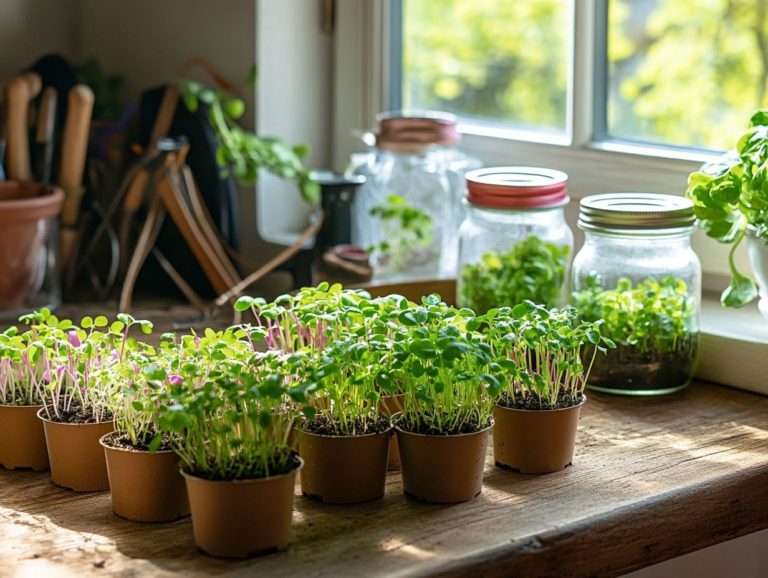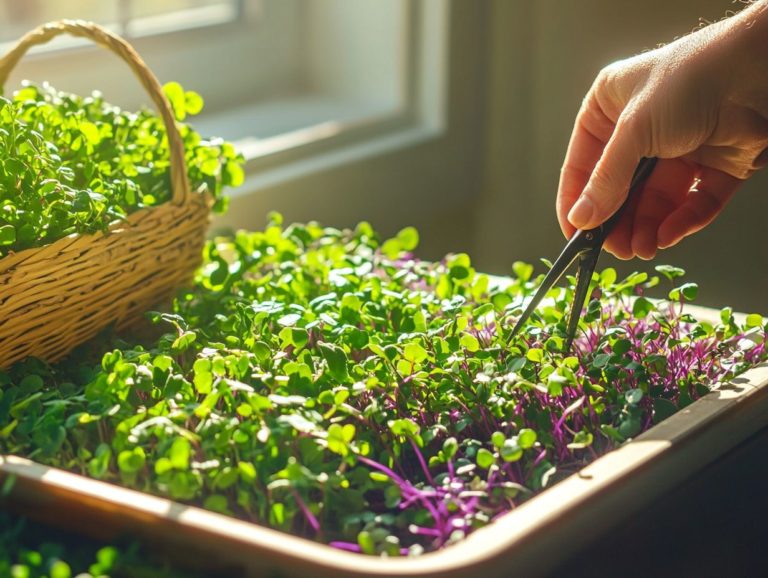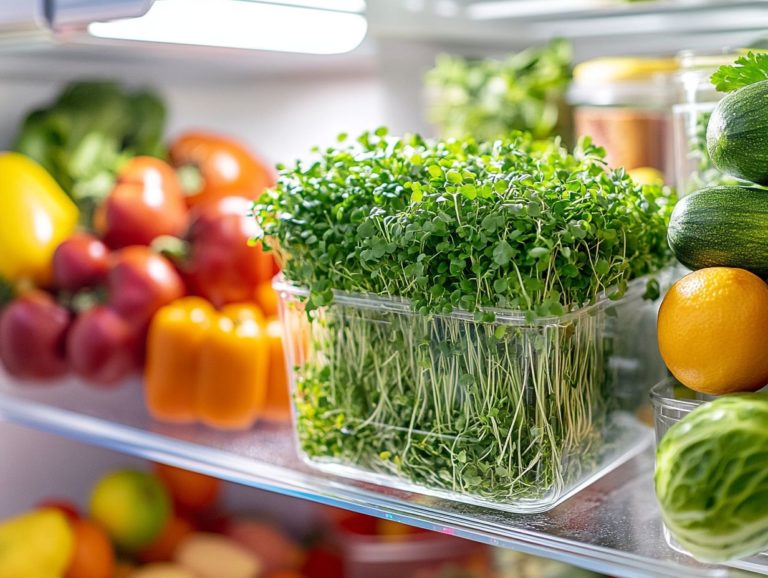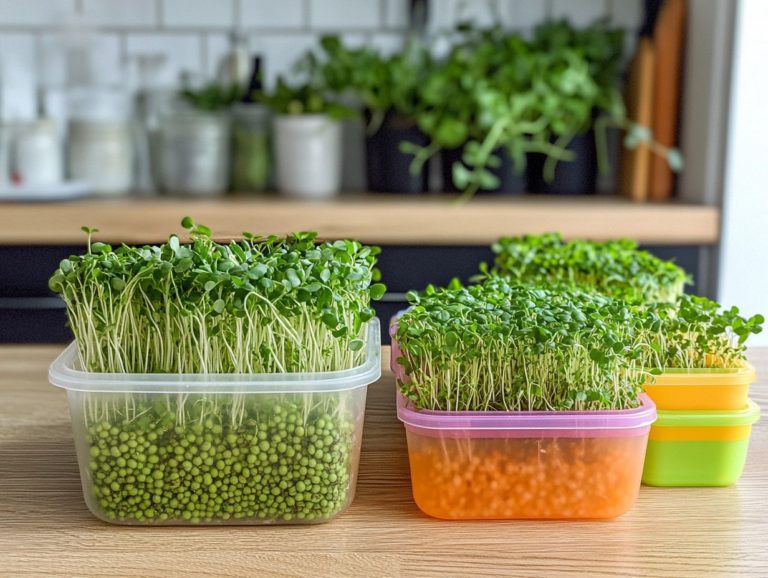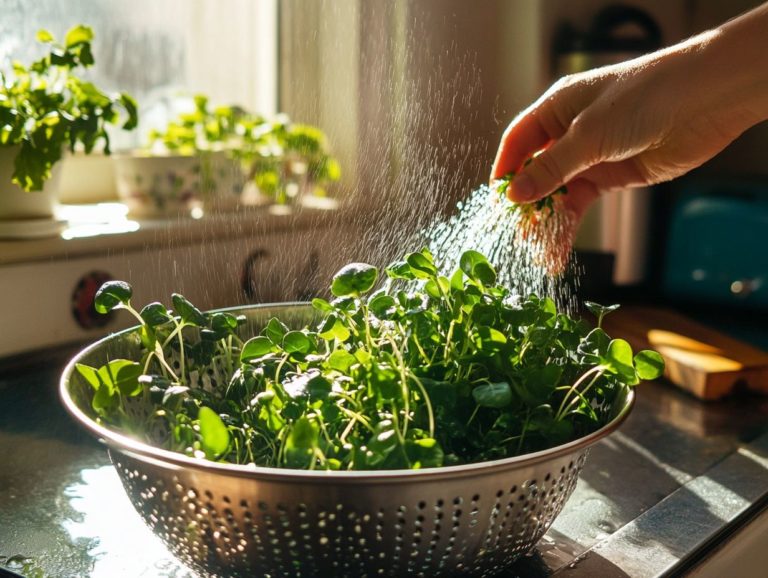Microgreens: How to Keep Them Crisp and Fresh
Microgreens have captured the culinary world s attention. They are celebrated for vibrant flavors and remarkable nutritional benefits.
This article explores microgreens and explains why they belong on your plate. You ll discover how to store them for freshness and tips to keep them crunchy.
Avoid common pitfalls that could compromise their quality.
Get ready to elevate your meals with these tiny powerhouses!
Contents
- Key Takeaways:
- Benefits of Microgreens
- How to Properly Store Microgreens
- Tips for Maintaining Crispness
- Common Mistakes to Avoid
- Frequently Asked Questions
- What are microgreens and why do they need to be kept crisp and fresh?
- Want to keep your microgreens fresh and crisp? Here s how!
- Can microgreens be washed before storing them?
- How often should microgreens be watered to keep them crisp and fresh?
- What is the ideal storage temperature for microgreens and how does it affect their freshness?
- How can I tell if microgreens have gone bad?
Key Takeaways:
- Store microgreens in the fridge, using a container lined with a paper towel to absorb moisture. This keeps them fresh for up to 10 days.
- Avoid direct sunlight and keep them away from ethylene-producing fruits to prevent wilting.
- Proper storage and avoiding mistakes like overcrowding can greatly impact their freshness and crunchiness.
What are Microgreens?
Microgreens encompass a delightful array of leafy greens and herbs like sunflower shoots, cilantro, arugula, and radish. They are young plants harvested just after the cotyledon leaves, the first leaves that a plant develops, have formed.
These vibrant greens are not just visually appealing; they are bursting with flavor and nutrition. Often cultivated in controlled environments such as greenhouses or urban farms, their nutritional benefits often surpass those of their mature counterparts.
With brands like JPure Farms and Donny Greens leading the charge, microgreens are swiftly gaining popularity among health-conscious consumers and gourmet chefs alike.
Their diversity is impressive, ranging from the spicy kick of mustard greens to the sweet crunch of pea shoots. This makes them versatile additions to countless dishes. Given that they require minimal space and flourish even in small batches, urban farming initiatives have eagerly adopted these nutrient-dense plants.
You can easily grow them indoors, which is perfect for home chefs eager to elevate their meals with fresh flavors.
This trend toward microgreens transcends mere taste. Their high concentrations of vitamins, antioxidants, and minerals make them an appealing choice for anyone looking to enhance daily nutrition. Grocery stores are increasingly recognizing this potential, stocking these miniature greens to elevate meals and promote overall wellness.
Benefits of Microgreens
The benefits of microgreens go well beyond enhancing your meals; they pack a powerful punch in terms of health benefits, making them an exceptional addition to your diet.
Packed with vitamins, minerals, and antioxidants, microgreens like cilantro and amaranth can significantly elevate your nutritional intake. Plus, their knack for thriving in controlled environments means you can enjoy them with minimal food waste, making them an eco-conscious choice that helps reduce municipal solid waste.
Nutritional Value and Culinary Uses
Microgreens are not just visually stunning; they are also packed with essential nutrients. They often contain higher levels of vitamins and minerals, such as vitamins C, E, and K.
These tiny greens can enhance the flavor of salads, sandwiches, and gourmet dishes. They are a staple in modern cuisine, featured in upscale restaurants.
Incorporating microgreens like arugula and sunflower shoots can add flavor and a satisfying texture to your meals. They can transform a simple dish into a nourishing experience that delights the senses.
How to Properly Store Microgreens
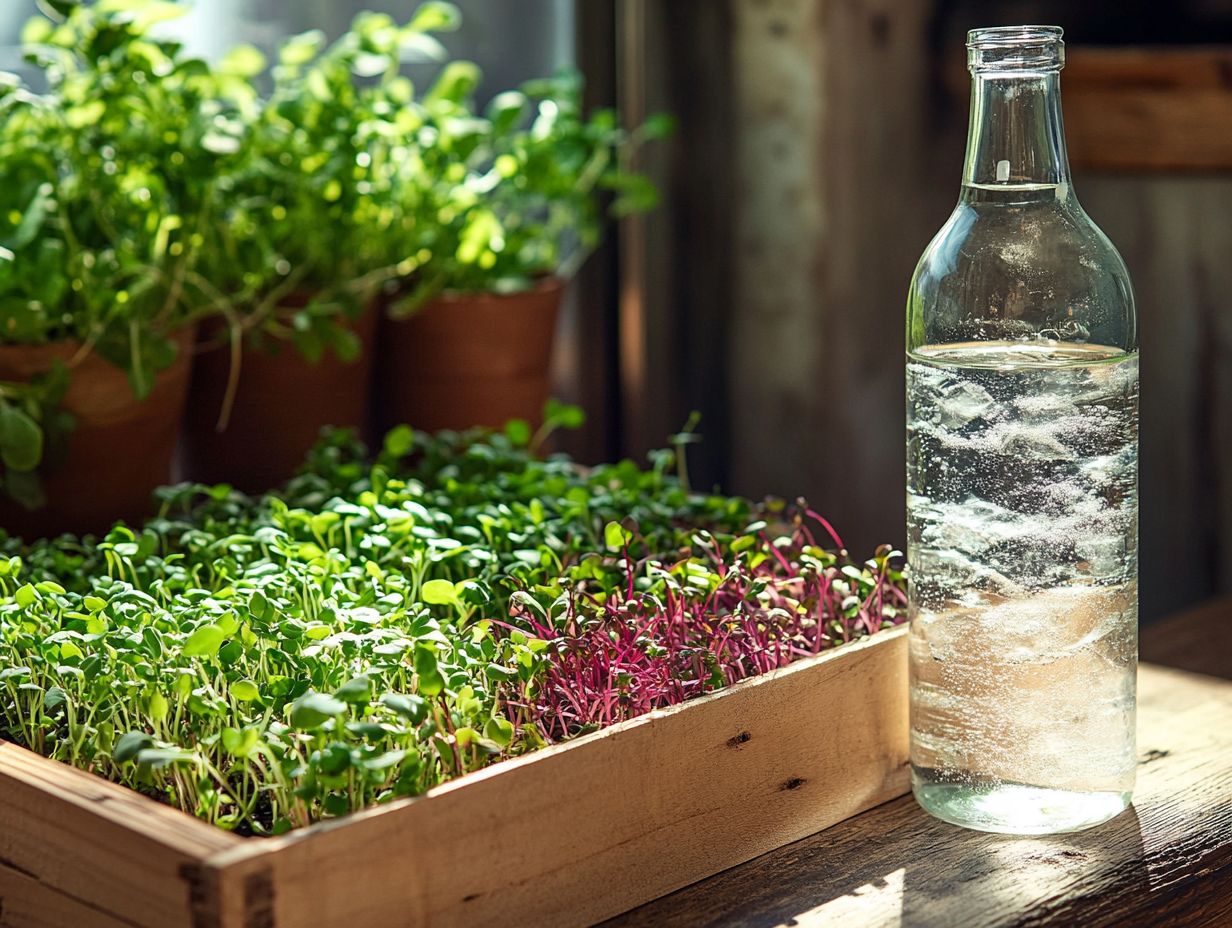
Properly storing microgreens is crucial for maintaining their freshness and extending their shelf life. Their quality can be affected by moisture, air circulation, and humidity.
For the best preservation, keep your microgreens in a cool, dry environment. Ideally, store them in the refrigerator or on a countertop, depending on the specific type of greens and how they re packaged.
Choose containers that promote air circulation, like glass bowls or clamshells. This helps prevent condensation and excess moisture, which could lead to wilting or spoilage.
Best Practices for Keeping Them Fresh
To ensure your microgreens remain fresh and vibrant, adhere to best practices that include meticulous washing, drying, and cutting techniques.
When washing your microgreens, use a safe cleaning agent, such as food-grade hydrogen peroxide, to eliminate any potential contaminants.
After washing, make sure to dry them thoroughly to remove excess moisture. This step helps prevent wilting.
A sharp blade is your best ally when cutting microgreens. It ensures they maintain their crispness and color, making them perfect for salads, garnishes, and other culinary masterpieces.
Handle these delicate greens with care; rough treatment can bruise them, compromising their appeal and flavor.
After washing, lay them flat on a clean kitchen towel or use a salad spinner for gentle drying without risking damage to the fragile leaves.
For longer storage, opt for a breathable container lined with a slightly damp paper towel to maintain the right level of humidity.
By following these practices, you not only enhance the longevity of your microgreens but also preserve their nutrient density. This ensures they deliver maximum flavor and health benefits.
Tips for Maintaining Crispness
Maintaining the crispness of microgreens is essential for both flavor and presentation. You can achieve this by preventing wilting and browning with effective storage techniques.
Ensure adequate air circulation and manage humidity levels to keep your microgreens vibrant and fresh. Monitor for excess moisture; using breathable containers can greatly assist in preserving their delightful crunchy texture. For more tips, check out the best methods for storing microgreens.
Preventing Wilting and Browning
Preventing wilting and browning in your microgreens requires careful attention to storage temperature and humidity levels. These elements are vital to their overall health and appearance.
Store your microgreens in a cooler environment, ideally between 34 F and 38 F. This temperature range effectively slows down respiration, helping to ward off wilting.
It s also important to monitor humidity levels; aim for around 50-70% relative humidity. This strikes the right balance, preventing excess moisture while keeping your greens well-hydrated.
Using breathable containers or perforated bags promotes airflow. This reduces condensation that could lead to browning.
By regularly checking your storage conditions and adjusting as necessary, you can significantly increase the lifespan of your microgreens, ensuring they stay vibrant and delicious for an extended period.
Common Mistakes to Avoid
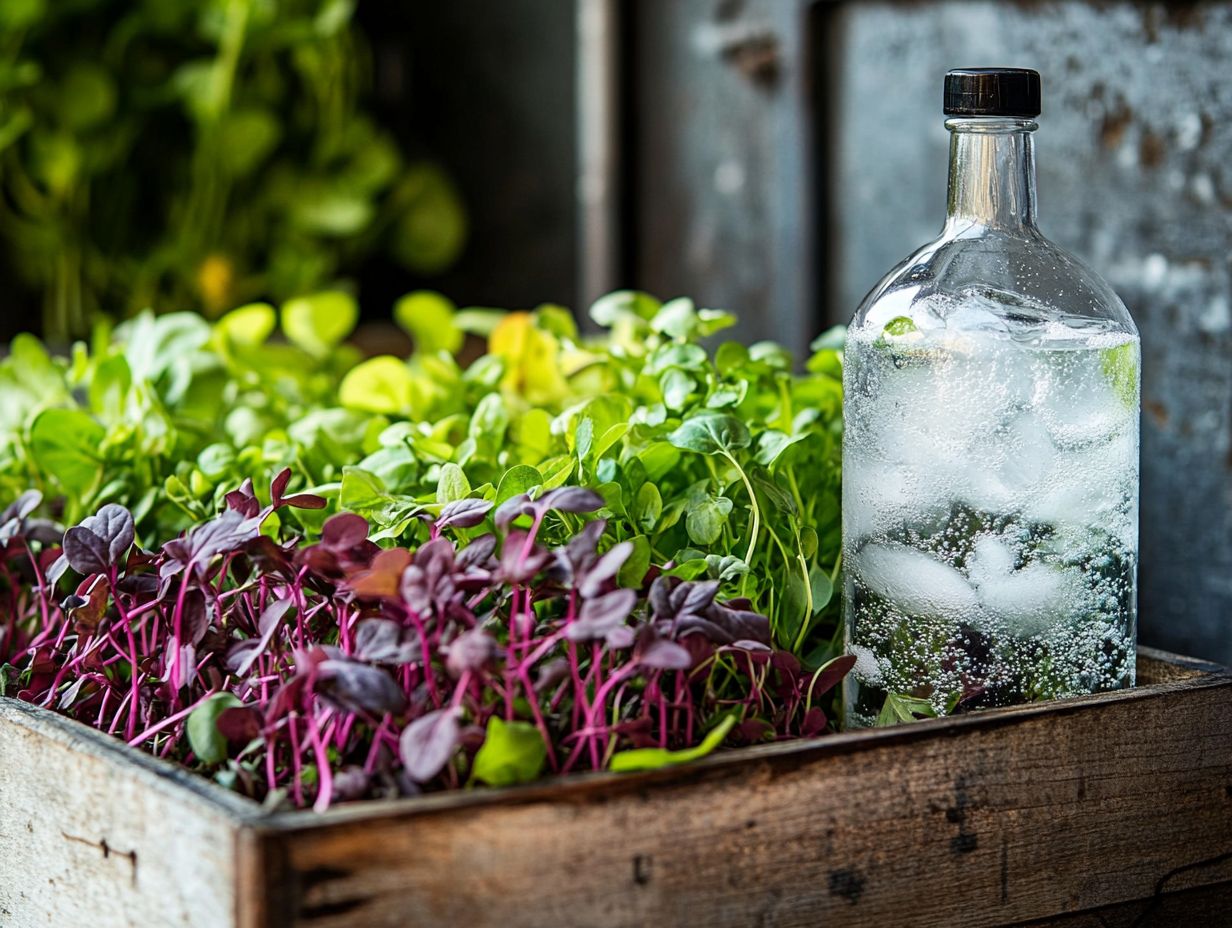
When storing microgreens, you might be making common mistakes that can compromise their freshness and nutritional value. Both are crucial for maximizing health benefits.
One prevalent error is neglecting to store them in the refrigerator. This oversight can lead to their premature deterioration.
If the packaging isn t sealed properly, it can trap moisture, which accelerates spoilage. Understanding these pitfalls is essential for anyone who wants to fully enjoy the remarkable potential of these nutrient-rich greens.
Start storing your microgreens the right way today for maximum freshness and flavor!
Factors that Can Affect Freshness
Numerous factors can impact the freshness of microgreens, including storage conditions, moisture levels, and air circulation. Knowing these factors can help you keep your microgreens fresher, longer!
Too much moisture can spoil them quickly, while insufficient air circulation creates a perfect breeding ground for decay. Temperature control is another critical factor; microgreens thrive in cooler environments, ideally between 50-60 F. To maintain their freshness, consider following tips for storing microgreens that help slow down the degradation process.
Exposure to light also plays a significant role in their vitality. Too much direct sunlight can lead to wilting or faded colors. Handle microgreens gently during harvesting to avoid bruising, which can compromise their freshness.
By being mindful of these environmental influences, you can significantly enhance the quality and longevity of these vibrant greens, making them more appealing to health-conscious consumers.
Frequently Asked Questions
What are microgreens and why do they need to be kept crisp and fresh?
Microgreens are tiny, edible seedlings of vegetables and herbs, harvested when they are just a few inches tall. They need to be kept crisp and fresh because they have high moisture content and can wilt or spoil quickly if not properly stored.
Want to keep your microgreens fresh and crisp? Here s how!
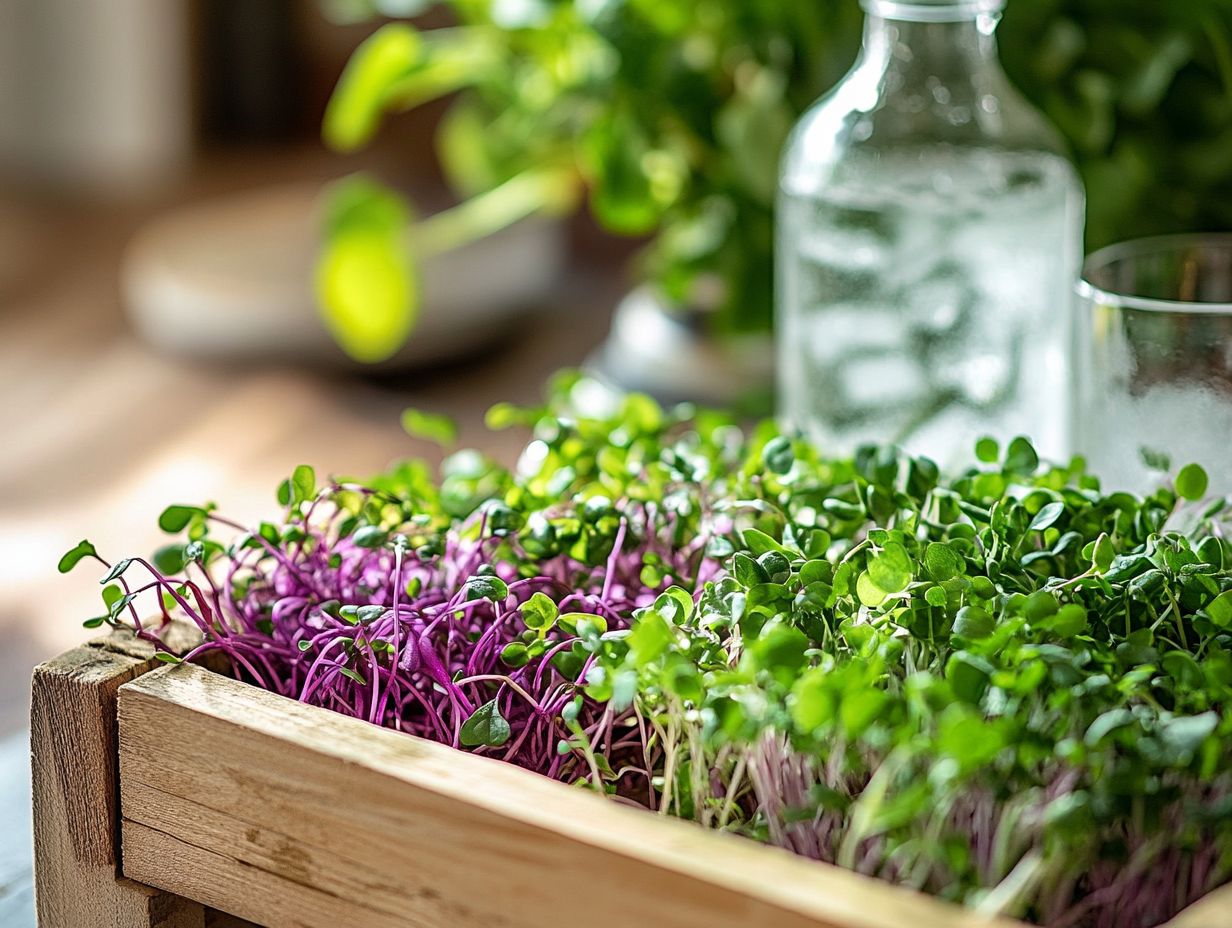
The best way to store microgreens is to wrap them loosely in a paper towel and place them in a sealed container or plastic bag. This absorbs extra water and keeps them crisp. They can also be stored in the refrigerator for up to a week.
Can microgreens be washed before storing them?
It is not recommended to wash microgreens before storing them. The extra water from washing can cause them to wilt and spoil faster. It s best to wash them right before consuming.
How often should microgreens be watered to keep them crisp and fresh?
Microgreens should be watered lightly once a day. It’s important not to overwater them, as this can make them soggy and lose their crispness. Use room temperature water to prevent shock to the plants.
What is the ideal storage temperature for microgreens and how does it affect their freshness?
The ideal storage temperature for microgreens is between 35-40 degrees Fahrenheit. This temperature range is typical for most refrigerators. Storing them at this temperature helps slow their growth and keeps them fresh for longer.
How can I tell if microgreens have gone bad?
If microgreens have gone bad, they will have a slimy texture and a foul odor. They may also appear wilted or discolored. If you notice any of these signs, it’s best to discard the microgreens.

